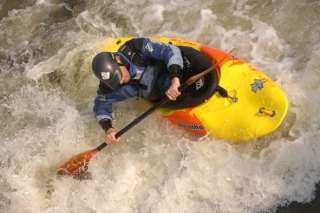
When it comes to choices, choosing your own kayak can be a major dilemma for those just starting out in this sport or lacking guidance on the subject.
Before even considering buying a kayak, we must remember that this water sport requires specialised and adapted equipment to be practised safely. It’s important to seek out professional companies and consult their sellers’ advice before making any purchase. But to narrow down your choice beforehand, we’ll go over some key points to help you select the most suitable kayak for you.
Know Yourself a Little
To paddle a kayak, you’ll need one that fits you well, where you feel comfortable and safe. The first things to know before visiting any shop are your body measurements and your experience level in the sport.
- Body: You should know your height and weight so that when consulting a seller, they can guide you correctly towards a kayak suited to your physique. Depending on the length and size of a kayak’s cockpit, you may feel more or less accommodated, which directly affects your comfort in the craft.
Ensuring the kayak fits your body will be essential if you plan to paddle for extended periods. A small kayak might not seem uncomfortable at first, but don’t be fooled! If you attempt an hour-long trip or more, lack of space can become a nightmare.
- Skill Level: This is equally crucial when choosing your kayak. On a scale of 1 to 10, you can rate your experience in this sport—1 being someone who’s never used a kayak and 10 being an expert kayaker.
Beyond assessing your current level, consider: Where do you see yourself in a couple of years?
This detail is important for positioning yourself in the kayaking world. Depending on your level, it may be more or less advisable to get a higher-performance kayak to match your progression and optimise your purchase. If you paddle regularly and plan to keep improving, it’s worth choosing a kayak slightly above your current skill level. Keep this question in mind, as your goals may steer you towards a more professional kayak.
Kayak Use
Choosing your own kayak can quickly become a maddening task simply because they come in all colours, shapes, sizes, and purposes. Since this sport can be practised in various aquatic environments (seas, lakes, and rivers), kayaks come in vastly different forms and models.

A river kayak could be a nightmare for a lake outing, while a touring kayak is entirely unsuited for navigating river rapids. So, after considering your body measurements and skill level, ask yourself: What will you use your kayak for?
There are many types of kayaks, each suited to different activities, but here are the main categories:
- Recreational Kayak: Simple and designed for enjoyment on lakes, slow rivers, or calm seas, this type is ideal for beginners, families, or occasional kayakers. Subcategories include open or enclosed cockpits, cargo space, or tandem models.

- Touring Kayak: For longer journeys, these kayaks are around 5 metres long and 55 centimetres wide. Narrow with storage compartments at the bow and stern, they allow you to carry all your essentials. Suitable for seas, lakes, or calm rivers on extended trips.

- Sea Kayak: Similar to touring kayaks but slightly wider, more comfortable, and robust, offering greater stability. Most are self-draining, meaning your legs stay exposed. Competition models vary in design and size.

- Fishing Kayak: These are self-draining, much like sea kayaks, but tailored for fishing. They’re fully equipped to carry fishing gear and provide the necessary stability for onboard angling. Suitable for seas, lakes, and calm rivers, like touring kayaks.

- Whitewater Kayak: The "river-running kayak," as the name suggests, is built for rapids. It lets you navigate turbulent waters, much like rafting boats. Think solo adventures on thrilling, raging rivers—one of the most exciting and extreme forms of kayaking. These kayaks are highly versatile, usable by beginners and experts alike, though pros often opt for more specialised models like "creek and squirt" or "playboat freestyle." They’re only suited for fast-flowing rivers and enable acrobatic moves.

- Foldable/Inflatable Kayak: These kayaks are either inflatable or collapsible. A great option for those with limited storage space. Though generally slower than hard-shell kayaks, they can be used on the sea, lakes, or even rivers.

Materials and Design
Historically, all small and large watercraft were made of wood, but today, kayaks come in various materials, each with pros and cons. You’ll mainly find fibreglass kayaks of differing quality, polyethylene composites, carbon kayaks, fabric kayaks, and wooden ones.
The topic of kayak construction materials often sparks heated debates among experts, making it hard to compare them qualitatively. Beyond differences in weight, durability, maintenance, and appearance, kayak prices vary widely by material.
Our best advice? Test as many kayaks on the water as possible before deciding. Whenever you can, try renting or borrowing a friend’s kayak to explore more options before committing to yours.

Aim for a good balance between your needs, aspirations, and budget when choosing. Note that a kayak with good resale value is a smart investment, especially for your first one. As your skills grow, your criteria may change quickly, and you might want a kayak better suited to your evolving needs.
Once you’ve pinpointed the right kayak, pick a colour and style that feels comfortable and reflects you. You’ll look way cooler if you genuinely enjoy being in it!











